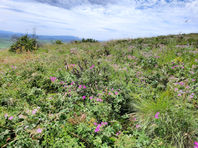
Palouse Prairie
The deep, fertile soils of the Palouse that support today's vast agricultural fields were once home to a sprawling prairie of bunchgrass and wildflower, with small patches of shrubs and trees. Today less than 1% of native Palouse Prairie habitat remains, fragmented into tiny pockets where it was historically too steep or rocky to farm. This makes it one of the most endangered ecosystems in the United States. Today's various land practices have caused nutrient depletion and heavy erosion in our soils. Re-establishing ecologically viable Palouse Prairie patches is an important step in creating healthy, diverse communities above and below ground.
Native plants are plants that occur naturally and historically within a region. They are the ecological foundation that native wildlife depend upon for survival.
Native species can be planted to restore Palouse Prairie patches in backyards and small acreages. This promotes connectivity between habitat patches for insects, birds, and small mammals that need it. In addition to adding habitat value, native species are specifically adapted to our region and growing conditions. As a result, these native species are hardier, lower-maintenance, and more drought-tolerant than non-native plantings. Their deep root systems serve to reduce erosion and store carbon below ground.
All of our restoration projects, from forests and streambanks to pastures and backyards, utilize native plants to benefit you, your land, and our native wildlife.
_JPEG.jpeg)

Benefits of Native Plants
Enhanced biodiversity · Support for pollinators
Carbon storage · Beauty · Water conservation · Erosion control
Low maintenance/fertilizer needed
Restoring Palouse Praire on your property can seem like a daunting task. Thankfully, there are many resources available to help you manage weeds, select plants, maintain your garden, and purchase supplies.
For tips on species selection, weed control, site maintenance, and where to purchase supplies, check out our new publication, Backyard Restoration on the Palouse (click here to view the PDF).
Click here to view our Backyard Prairie Restoration Resource List!
Contact us!
For questions on Palouse Prairie restoration...
Lauren Kirkpatrick | LaurenK@PalouseCD.org | (509) 553-1852
For questions on weed management...
Randy Stevens | RandyS@PalouseCD.org | (509) 553-1851











